Copyright
To obtain a copy of this publication or an alternate format (Braille, large print, etc.), please fill out the Publication Request form or contact:
Web Services Centre
Innovation, Science and Economic Development Canada
C.D. Howe Building
235 Queen Street
Ottawa, ON K1A 0H5
Canada
Telephone (toll-free in Canada): 1-800-328-6189
Telephone (Ottawa): 613-954-5031
TTY (for hearing-impaired): 1-866-694-8389
Business hours: 8:30 a.m. to 5:00 p.m. (Eastern Time)
Email: ISED@canada.ca
Permission to Reproduce
Except as otherwise specifically noted, the information in this publication may be reproduced, in part or in wholeand by any means, without charge or further permission from the Department of Industry, provided that due diligence is exercised in ensuring the accuracy of the information reproduced; that Industry Canada is identified as the source institution; and that the reproduction is not represented as an official version of the information reproduced, nor as having been made in affiliation with, or with the endorsement of, the Department of Industry.
For permission to reproduce the information in this publication for commercial purposes, please fill out the Application for Crown Copyright Clearance or contact the Web Services Centre (see contact information above).
© Her Majesty the Queen in Right of Canada,
as represented by the Minister of Industry, 2016
Cat. No. Iu188-113/5-2016E-PDF
ISBN 978-0-660-05019-5
Aussi offert en français sous le titre Profil des PME : les coopératives au Canada, avril 2016.
Patrice Rivard
Research and Analysis Directorate, Small Business Branch
Innovation, Science and Economic Development Canada
Summary:
Executive summary
This profile, for the first time in Canada, compares data on co-operatives with those of small and medium-sized enterprises (SMEs). A co-operative is a legally incorporated corporation that is owned by an association of member-owners seeking to satisfy common needs such as access to goods or services, sale of their goods or services, or employment. Co-operatives are a democratic business model that operates on a "one member, one vote" principle. This report specifically considers for-profit co-operatives that are SMEs. Leveraging the findings of the Survey on Financing and Growth of Small and Medium Enterprises, 2014 (SFGSME), it addresses various characteristics of co-operatives, such as types of financing sought, growth, exports and innovation activity. The benefit of the SFGSME is that it provides data on co-operatives whose characteristics are rarely studied in Canada.
The SFGSME shows that 51.3% of SMEs requested external financing in 2014, compared with 69.8% of co-operatives. The type of financing most often requested by co-operatives was debt financing, whereas for SMEs, it was trade credit; debt financing ranked second for SMEs. However, debt financing accounted for 53.8% and 52.3%, respectively, of the total value of financing received by co-operatives and SMEs. Co-operatives received $148.7 million in debt financing, whereas SMEs received $28.0 billion. By comparison, trade credit accounted for 37.2% of the total financing for co-operatives and 30.5% for SMEs, which, in monetary terms, translated to $102.6 million for co-operatives and $16.3 billion for SMEs.
Co-operatives and SMEs differed significantly in terms of the source of debt financing received. Credit unions or caisses populaires were the source of funds for 73.2% of co-operatives that received debt financing. By comparison, Canadian chartered banks were the source of funds for 71.6% of SMEs that received debt financing.
The SFGSME also brings to light specific business characteristics. According to the results, 78.1% of co-operatives had been in business for more than 20 years, compared with 36.6% of SMEs. Further, co-operative start-ups were proportionately fewer in number than SME start-ups; about 1.2% of co-operatives had been in business for two years or less in 2014, compared with 7.6% of SMEs. Another interesting fact revealed by the data relates to the growth of small and medium-sized enterprises during the period 2012–2014. Some 9.3% of SMEs showed strong growth, i.e. an average annual growth exceeding 20%, compared with 5.3% of co-operatives. About one-third of SMEs experienced zero or negative average annual growth, compared with one-quarter of co-operatives. Finally, half of SMEs experienced an average annual growth of 1–10%, whereas 57.7% of co-operatives experienced growth in this range.
The data from the SFGSME show that approximately 11.8% of SMEs reported that they had exported goods or services in 2014, compared with 6.0% of co-operatives. In both cases, exporting businesses reported that the United States was the main export destination.
Finally, the SFGSME sheds some light on SMEs' innovation activity from 2012 to 2014. This activity could involve the introduction of a good or service, a significantly improved production method, a new organizational process or a new way of selling goods or services. The survey found that 41.6% of SMEs had carried out at least one of the aforementioned innovation activities, compared with 46.3% of co-operatives.
1. Introduction
For the first time in Canada, a data comparison can be made between co-operatives and SMEs, as a result of the Survey on Financing and Growth of Small and Medium Enterprises, 2014 (SFGSME). The widely accepted definition of co-operative is shown in the box below.
Key definition
- Co-operative:
- a co-operative is a legally incorporated corporation that is owned by an associationof member-owners seeking to satisfy common needs such as access to goods or services, sale oftheir goods or services, or employment.
Source: Industry Canada, Co-operatives in Canada in 2010.
Co-operatives operate differently from other businesses on various levels. First, the ownership of a co-operative is shared among the members that use its goods or services. It must be noted that a co-operative may include members that do not necessarily use its goods or servicesFootnote 1 (e.g. investor members). Second, co-operatives are governed according to the principle of "one member, one vote." Thus, the members of a co-operative make decisions democratically and shareholders cannot have a majority vote. Another significant aspect of co-operatives relates to profits, which are distributed, in whole or in part, as patronage dividends to all members.
In Canada, a co-operative must incorporate under a specific co-operative Act at the provincial, territorial or federal level. While co-operatives exist in a broad array of sectors and serve a wide variety of functions, they generally fit one of the following four types:Footnote 2
- Consumer co-operatives: provide goods and services to their members;
- Producer co-operatives: process and market their members' goods and services;
- Worker co-operatives: provide their members with employment services. The employees are the members and owners of the enterprise;
- Multi-stakeholder co-operatives: respond to the needs of various stakeholder groups, such as employees, clients and interested persons or organizations.
According to the data of the 2010 Annual Survey of Canadian Co-operatives,Footnote 3 not to be confused with the SFGSME, there were 7,865 co-operatives in Canada in 2010, of which 5,094 took part in this survey. The results show that 70.2% of co-operatives were consumer co-operatives, which are generally involved in retail or wholesale activities. Producer co-operatives were the second-largest group, accounting for 16.2% of the co-operatives in the sample.
Co-operatives are of interest to governments because of their contributions to economic development and their social impact.Footnote 4 On the economic front, the 2010 Annual Survey of Canadian Co-operatives shows that the co-operatives that completed the survey employed 87,963 Canadians and generated revenues totalling approximately $34 billion, and held more than $21 billion in assets such as real estate or equipment.
The United Nations highlighted the importance of co-operatives when it declared 2012 as the "International Year of Co-operatives." In 2012, Canada created a "Special Committee on Co-operatives" to review the status of co-operatives in Canada.Footnote 5 As a result, Innovation, Science and Economic Development Canada was required to hold the policy responsibility for non-financial co-operatives and provides analysis, advice and support to promote co-operatives' business innovation and growth in Canada.
One of the necessary conditions for establishing effective policies on co-operatives is access to data that concern them. In Canada, the main source of reliable information is the Annual Survey on Canadian Co-operatives, which has been conducted every year since the 1930s. A new source of information has since been added: the SFGSME. Data provided by this second survey specifically concern private, for-profit co-operatives with 1 to 499 employees that have achieved gross revenue of $30,000 or more. The SFGSME sheds additional light on co-operatives, as it contains data on financing requests and business characteristics, such as age or average annual growth.
Data Source and Definitions
This statistical profile uses as its main source of data the SFGSME conducted by Statistics Canada from February to May 2015, to which 10,397 businesses responded, for a response rate of 61%. According to Statistics Canada, these respondents form a representative sample of 621,417 SMEs of the survey's target population. For co-operatives, the sample is representative of 739 co-operatives of the survey's target population.
The term business refers to any commercial establishment registered in the Business Register. This register contains a list of all active businesses in Canada that have a corporate income tax account (T2), are an employer or have a Goods and Services Tax account.Footnote 6
The SFGSME excludes any business with 0 employee or with 500 employees or more, that has gross revenue of less than $30,000, that is a non-profit organizationFootnote 7 or a public agency, and that is a member of specific business groups.Footnote 8 The sample does not include any financial co-operatives such as credit unions or caisses populaires.
According to Innovation, Science and Economic Development Canada, a small or medium-sizedenterprise (SME) has from 1 to 499 employees. In fact,
- a small enterprise has 1 to 99 employees;
- a medium-sized enterprise has 100 to 499 employees.
2. Financing of co-operatives
This section deals specifically with the financing requests made by co-operatives in 2014 and will compare co-operatives with the results from the survey's SMEs population.
Financing request
According to the SFGSME, approximately 51.3% of SMEs requested external financing in 2014. These requests included the following:
- debt financing;
- non-residential mortgage loan;
- commercial line of credit;
- term loan;
- commercial credit card;
- lease financing;
- trade credit financing;
- equity financing;
- government financing through grants or non-repayable contributions.
The overall rate of external financing requests made by co-operatives was 69.8%. That is, approximately 7 out of 10 co-operatives requested external financing, compared with approximately 5 out of 10 SMEs.
Type of financing
The type of financing requested by co-operatives and SMEs is shown in Figure 1. Generally speaking, the type of financing was similar for both small and medium-sized enterprises and for co-operatives, with two notable distinctions. First, a larger proportion of co-operatives (38.6%) requested debt financing than did SMEs (28.1%). Second, SMEs requested government grants and contributions to a lesser extent (4.4%) than co-operatives (14.8%).
Figure 1: Type of external financing requestedby co-operatives and SMEs (percentage)Footnote 9

Source: Statistics Canada, Survey on Financing and Growth of Small and Medium Enterprises, 2014.
Debt financing was the type of external financing most often requested by co-operatives, whereas trade credit was the type most often requested by SMEs.
Equity financing was ranked last for SMEs, while lease financing was ranked last for co-operatives.
The data collected by the SFGSME also provide information on the total amount received by type of financing (Table 1). The total amount of debt financing received by co-operatives was approximately $148.7 million, whereas for SMEs, it was about $28.0 billion. Note that for SMEs, although debt financing was ranked lower than trade credit financing in terms of requests, debt financing was almost double that of trade credit ($16.3 billion) in terms of amount received.
| Type of financing | Co-operatives | SMEs |
|---|---|---|
| Source: Statistics Canada, Survey on Financing and Growth of Small and Medium Enterprises, 2014. | ||
| Debt | 148.7 | 28,023.5 |
| Trade credit | 102.6 | 16,328.8 |
| EquityFootnote 10 | 9.3 | 3,336.6 |
| Government grants or contributionsFootnote 11 | 8.8 | 1,218.3 |
| LeasingFootnote 12 | 6.8 | 4,630.9 |
| Total | 276.2 | 53,538.2 |
Debt and trade credit financing alone accounted for about 91.0% of the total amount of financing received by co-operatives (Figure 2). The proportion for SMEs was approximately 82.8%. The gap between the two can be explained by the fact that the proportion of trade credit financing received by SMEs was lower than that received by co-operatives; it accounted for 37.2% of the total financing for co-operatives and 30.5% for SMEs.
Figure 2: Proportion of total financing received by co-operatives and SMEs, by type of financing (percentage)

Source: Statistics Canada, Survey on Financing and Growth of Small and Medium Enterprises, 2014.
Amount of financing
The average amount requested by and authorized to co-operatives and all SMEs for various types of financing (debt, trade credit and leasing), the overall approval rateFootnote 13 and the total amount authorized-to-requested are presented in Table 2.
| Type of financing | Co-operatives | SMEs | ||||||
|---|---|---|---|---|---|---|---|---|
| Average amount requested | Average amount authorized | Overall approval rate | Total amount authorized-to-requested | Average amount requested | Average amount authorized | Overall approval rate | Total amount authorized-to-requested | |
| Note: "n/a" indicates that the average amount requested or the total amount authorized-to-requested is not applicable to trade credit financing. Source: Statistics Canada, Survey on Financing and Growth of Small and Medium Enterprises, 2014. | ||||||||
| Debt | $542,444 | $534,754 | 93.2% | 98.6% | $194,500 | $167,541 | 82.1% | 86.1% |
| Trade credit | n/a | $388,739 | 99.3% | n/a | n/a | $91,030 | 98.3% | n/a |
| LeasingFootnote 14 | $148,219 | $148,219 | 100.0% | 100.0% | $97,284 | $95,669 | 98.2% | 98.3% |
In 2014, the overall approval rate of debt financing was 93.2% for co-operatives and 82.1% for SMEs. The average debt financing amounts requested by and authorized for co-operatives were approximately three times higher than for SMEs. In addition, the total amount authorized-to-requested was 98.6% for co-operatives and 86.1% for SMEs. These data could suggest that the total amount authorized-to-requested is higher for co-operatives than for SMEs; however, these ratios apply only to the survey samples and not to the entire population of SMEs and co-operatives in Canada.Footnote 15 In terms of trade credit financing, the survey data show that the average amount authorized for co-operatives was approximately four times greater than for SMEs. Furthermore, both co-operatives and SMEs achieved a very similar overall approval rate, i.e. 99.3% and 98.3%, respectively.
Debt financing
Providers of debt financing
Co-operatives and SMEs differed significantly in terms of the provider of authorized debt financing. The large majority of SMEs—71.6% to be exact—received their debt financing from Canadian chartered banks, while 73.2% of co-operatives received their debt financing from credit unions or caisses populaires, which are co-operative financial institutions.
The various debt financing providers for co-operatives and SMEs are shown in Figure 3. Results apply only to businesses whose debt financing was approved, and thus received, in 2014.
Figure 3: Providers of debt financing received by co-operatives and SMEs (percentage)
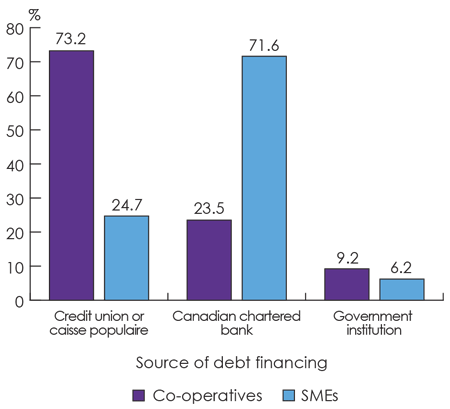
Source: Statistics Canada, Survey on Financing and Growth of Small and Medium Enterprises, 2014.
Debt financing by type of instrument
Various kinds of debt financing are available to businesses. The SFGSME reviewed the four most common types: non-residential mortgage loan, line of credit, term loan and credit card. We consider the rate of request and the total amount authorized-to-requested below (Table 3).
| Debt instrument | Co-operatives | SMEs | ||
|---|---|---|---|---|
| Rate of request | Total amount authorized-to-requested | Rate of request | Total amount authorized-to-requested | |
| Note: "X" indicates that data were suppressed by Statistics Canada to meet the confidentiality requirements of the Statistics Act. Source: Statistics Canada, Survey on Financing and Growth of Small and Medium Enterprises, 2014. | ||||
| Mortgage loan | 12.1% | X | 4.3% | 85.5% |
| Line of credit | 17.1% | 98.5% | 13.8% | 85.2% |
| Term loan | 11.2% | X | 6.9% | 88.0% |
| Commercial credit card | 10.2% | X | 11.2% | 91.5% |
The line of credit was the debt instrument most often requested by SMEs and co-operatives. For SMEs, the second-ranked debt instrument was the commercial credit card, whereas for co-operatives, it was the mortgage loan. The mortgage loan was the least requested instrument for SMEs, while the commercial line of credit was the least requested instrument for co-operatives. Finally, co-operatives had a total amount authorized-to-requested of 95.5% for lines of credit, compared with 85.2% for SMEs.
Intended use of general debt
In the case of debt financing, it is possible to identify the intended use of the debt by the business (Figure 4). The most common use of the debt for both SMEs (61.9%) and co-operatives (49.4%) was the firm's working capital or operating fund. The second most common use for 27.0% of SMEs was the acquisition of machinery or equipment, and for 28.4% of co-operatives, it was the acquisition of buildings or land. In addition, research and development (R&D) was the lowest-ranked use both for SMEs and co-operatives. Only 5.5% of SMEs and 3.7% of co-operatives considered using their debt financing on R&D.
Figure 4: Intended use or acquisition of the debt financing (percentage)
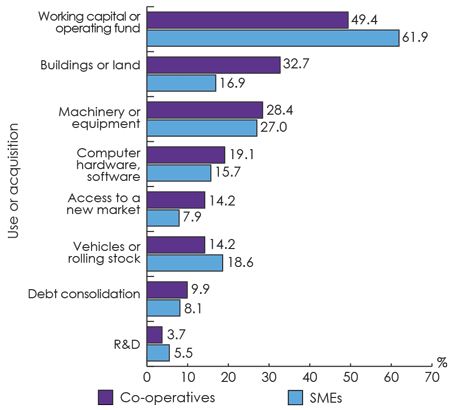
Source: Statistics Canada, Survey on Financing and Growth of Small and Medium Enterprises, 2014.
3. Business information
This section will analyze specific characteristics of the firms, such as their age, growth, exports and innovation activity.
Age
The average age of co-operatives was approximately 2.5 times that of SMEs (Figure 5). In fact, co-operatives were, on average, 46.7 years old, whereas SMEs were, on average, 19.0 years old.
Figure 5: Breakdown (percentage) of co-operatives and SMEs based on the age of the business
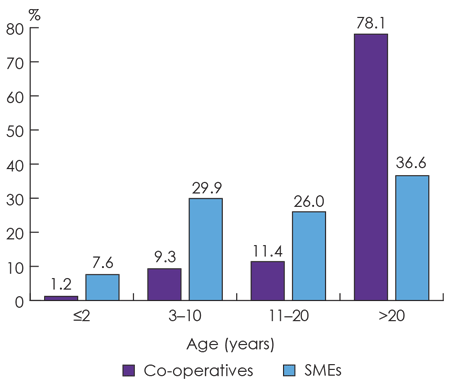
Source: Statistics Canada, Survey on Financing and Growth of Small and Medium Enterprises, 2014.
This figure also shows that 78.1% of co-operatives were more than 20 years old, whereas only 36.6% of SMEs were that age. Thus, co-operatives were older than SMEs. In addition, fewer co-operatives than SMEs were newly created: only 1.2% of co-operatives, compared with 7.6% of SMEs, were two years old or less.
Growth
Based on the data collected by the SFGSME, only 9.3% of SMEs were high-growth businesses (Figure 6). The proportion of high-growth co-operatives was slightly lower, at 5.3%. The survey also found that one-third of SMEs experienced zero or negative average annual growth in sales or revenue from 2012 to 2014. By comparison, about one-fourth of co-operatives experienced zero or negative average annual growth. The largest proportion of SMEs and co-operatives achieved an average annual growth of 1% to 10%. In fact, 49.7% of SMEs and 57.7% of co-operatives fell in this range.
Figure 6: Breakdown (percentage) of co-operatives and SMEs based on ranges of average annual growth of total sales or revenue

Source: Statistics Canada, Survey on Financing and Growth of Small and Medium Enterprises, 2014.
Obstacles to growth
The previous section showed that one-third of SMEs and approximately one-fourth of co-operatives experienced zero or negative average annual growth. That is why we will now attempt to determine if SMEs and co-operatives face the same obstacles to growth. Those barriers considered major by businesses are outlined below.
Generally speaking, co-operatives and SMEs practically faced the same major obstacles to growth, barring a few exceptions. Twenty four percent (24%) of co-operatives considered increased competition to be a major obstacle to growth (Figure 7), the obstacle cited by the largest proportion of co-operatives. Increased competition was ranked second by SMEs, 18.7% of which considered it to be a major obstacle to their growth. Shifting demand was considered to be a major obstacle by the highest proportion of SMEs, i.e. 19.4%. This obstacle was ranked second by co‑operatives, 18.1% of which considered it to be a major obstacle to growth. The taxation rate was the least major obstacle, with only 4.5% of co-operatives considering it to be major. Lastly, obtaining financing was considered to be a major obstacle to growth by only 9.2% of SMEs and 8.3% of co-operatives.
Figure 7: Major obstacles to growth of co-operatives and SMEs (percentage)Footnote 16
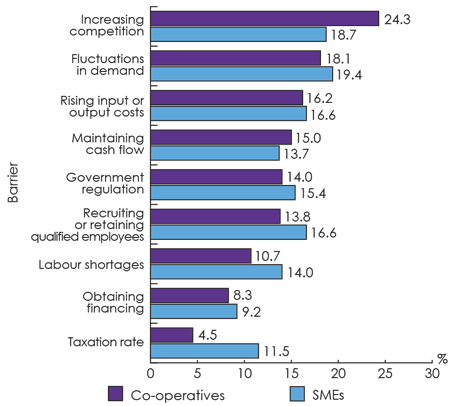
Source: Statistics Canada, Survey on Financing and Growth of Small and Medium Enterprises, 2014.
Exports
The SFGSME shows that very few Canadian businesses exported goods or services outside of Canada. In fact, 11.8% of SMEs responded that they exported goods or services in 2014 and the proportion of exporting co-operatives was even lower, at 6.0%.
The export destination for co-operatives and SMEs is shown in Figure 8. The most common destination was the United States, to which 96.0% of co-operatives and 89.2% of SMEs exported goods or services. In addition, 24.0% of co‑operatives exported to Asian countries other than China, compared with 15.5% of SMEs.
Figure 8: Export destinations for co-operatives and SMEs (percentage)Footnote 17

Source: Statistics Canada, Survey on Financing and Growth of Small and Medium Enterprises, 2014.
Obstacles to exports
Given data confidentiality constraints, it is not possible to ascertain the percentage of co-operatives which considered some issues solely and strictly to be a major obstacle. However, it is possible to consider the issues that were not an obstacle for both co-operatives and SMEs.
The vast majority of co-operatives, i.e. 84.0%, stated that administrative issues in Canada, such as legal rules, regulations and requirements, were not an obstacle to exports (Figure 9). By comparison, 72.9% of SMEs felt the same way. Intellectual property issues were not a barrier for 81.1% of SMEs and 80.0% of co-operatives.
Figure 9: Issues which co-operatives and SMEs do not consider to be an obstacle to exports (percentage)Footnote 18
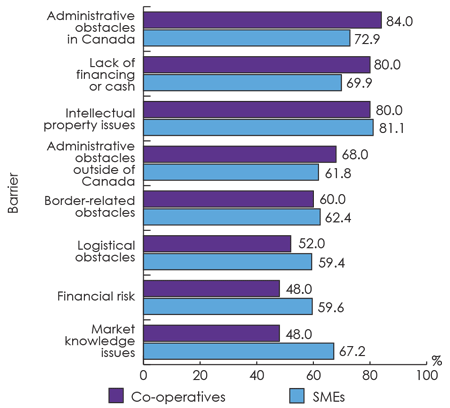
Source: Statistics Canada, Survey on Financing and Growth of Small and Medium Enterprises, 2014.
Only about half of co-operatives (48.0%) felt that financial risk and market knowledge issues were not obstacles to exports, compared with 59.6% and 67.2% of SMEs, respectively. Logistics was not considered an obstacle by 59.4% of SMEs and 52.0% of co-operatives.
Innovation
The SFGSME helps to determine whether businesses undertook innovation activities during the period 2012–2014. The Organisation for Economic Co-operation and Development (OECD) suggests four innovation categories:Footnote 19 product innovation, process innovation, organizational innovation and marketing innovation. The SFGSME shows that 41.6% of SMEs undertook at least one type of innovation, compared with 46.3% of co-operatives. In addition, Table 4 shows the types of innovation activities created or initiated by co-operatives and SMEs from 2012 to 2014.
| Innovation activity | Co-operatives | SMEs |
|---|---|---|
| Source: Statistics Canada, Survey on Financing and Growth of Small and Medium Enterprises, 2014. | ||
| Products (goods or services) | 29.5% | 25.6% |
| Process | 16.1% | 17.7% |
| Organizational | 21.5% | 19.0% |
| Marketing | 19.3% | 19.5% |
| At least one activity | 46.3% | 41.6% |
Product (goods or services) innovation was the innovation activity undertaken by the largest number of SMEs and co‑operatives, at 25.6% and 29.5%, respectively (Table 4). Process innovation was the lowest-ranked activity, undertaken by 17.7% of SMEs and 16.1% of co-operatives.
4. Conclusion
For the first time in Canada, the 2014 Survey on Financing and Growth of Small and Medium Enterprises (SFGSME) allows researchers to compare the characteristics of for-profit small and medium-sized co-operatives with those of small and medium-sized enterprises (SMEs). It includes data on the financing, growth, export and innovation activities of surveyed Canadian SMEs and co-operatives.
The survey found that compared with SMEs, for-profit small and medium-sized co-operatives tended to:
- be more likely to request external financing;
- use debt financing most frequently as opposed to trade credit for SMEs;
- have significantly higher approval rates for debt financing (93% and 82% for co-operatives and SMEs respectively);
- use credit unions or caisses populaires as sources of debt financing;
- be in business far longer than SMEs (78% were over 20 years old); and
- be more likely to claim to have conducted some form of innovation activity—the introduction of a significantly improved good or service, a new production method, a new organizational process or a new way of selling goods or services—during the period from 2012 to 2014.
Interestingly, 5.3% of co-operatives exhibited a high growth rate (an average annual growth rate in total sales or revenue that exceeded 20%) during the 2012–2014 period. While less than the 9.3% of SMEs with a high growth rate during that period, the percentage of co-operatives with a high growth rate is still very significant. Overall, 75% of co-operatives experienced a positive average annual growth during that period. Co-operatives and SMEs cited "increased competition" and "fluctuating demand" as the two largest obstacles to growth.
Some co-operatives also export goods or services. However presently, co-operatives are about half as likely to export, when compared with SMEs. Six percent (6%) of co-operatives reported that they had exported goods or services in 2014.
The 2014 SFGSME provides a new source of information on how, compared with SMEs, co-operatives operate and the challenges they face. The survey also contributes to augment data from other sources that researchers can use to further drive the economic and social impact that co-operatives make in Canada.
